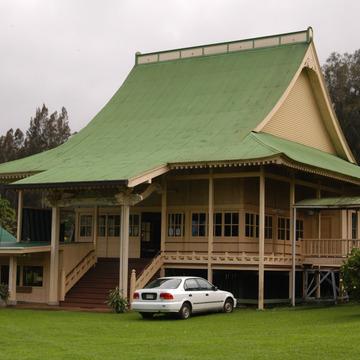The Hamakua Jodo Mission is the sole surviving Buddhist temple in Hawaii to follow the traditional Japanese kiwari (proportional) system, with the Japanese shaku unit of measure. Raised six feet off the ground, the building is forty-three feet high, with its irimoya roof representing slightly more than half of the overall height. Displaying a high level of craftsmanship, the building features elegant carved ornamentation inside and out. The imposing roof, the engawa's (verandah) traditional kōran (railing), and the well-designed kōhai, with its elbow brackets, ornately carved mizuhiki koryo (front beam), and ebi koryo (lobster tie beam), convey an immediate identification with Japan. The building also reflects a plantation-based influence, as seen in the wide engawa wrapping around the front and sides, tongue-and-groove walls, corrugated-metal roof, double-hung sash windows, and four-pane, three-panel sliding doors between the moya (sacred central area of the temple) posts.
The Jodo sect was introduced into Hawaii in 1896, with the Hamakua temple serving the Islands' first congregation. The present temple is the second to serve the congregation. Its carpenter, Umekichi Tanaka, had experience in temple construction in Japan. Born in 1859 in Fukuoka Prefecture, the son of a shrine carpenter, Tanaka was trained in this field under the Fujiware Toshiaki clan. At the age of thirty-nine when he received his carpentry certificate, he immigrated to Hawaii as a contract laborer. Here he worked as a carpenter for Paauhau Plantation. The Hamakua Jodo Temple is the only temple in Hawaii known to have been built by Tanaka, and was undertaken by him and the community during off hours, primarily weekends. Paauhau Plantation donated the materials for the building and assisted in hauling them to the site. The plantation manager also allowed four koa trees to be removed from the forests behind the temple. Tanaka and two others used these to carve the ramma (transom) and zushi (shrine) of the temple's raised naijin (chancel). The ramma depicting the dragon in the ocean waves is one of the few hand carved in Hawaii, as most of them were purchased from Japan. The zushi includes a high shumidan (dais) housing the Amida Buddha.















